Queen's College, London
Queen's College is an independent school for girls aged 11–18 with an adjoining prep school for girls aged 4–11 located in the City of Westminster, London. Founded in 1848 by theologian and social reformer Frederick Denison Maurice along with a committee of patrons, the College was the first institution in the world to award academic qualifications to women. In 1853, it also became the first girls' school to be granted a Royal Charter for the furtherance of women's education.[1] Ever since, the College patron has been a British queen; the current patron is Queen Elizabeth II.[2]
| Queen's College London | |
|---|---|
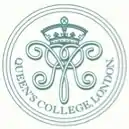 | |
| Address | |
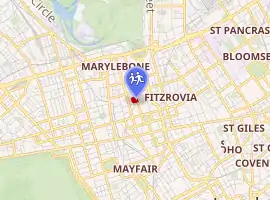
| |
43–49 Harley Street London , W1G 8BT England | |
| Information | |
| Type | Independent day school |
| Established | 1848 |
| Founder | Frederick Denison Maurice |
| Local authority | City of Westminster |
| Department for Education URN | 101157 Tables |
| Chair of Governors | Alison While |
| Principal | Richard Tillett |
| Gender | Girls |
| Age | 4 to 18 |
| Enrolment | 520~ |
| Colour(s) | |
| Former pupils | Old Queen's |
| Website | www |
The College has a distinctly liberal ethos based upon the principles of F. D. Maurice.
History

In 1845 David Laing, chaplain of the Middlesex Hospital raised funds with a committee of patrons to acquire a building at 47 Harley Street with the intention of creating a home for unemployed governesses.
Laing was keen to develop the institution to provide governesses with an education and certification. In 1847 he acquired the agreement of professors from King's College London to give lectures in the Home. Queen Victoria gave her assent, promise of funds and patronage. In 1847 the first lectures took place, the Committee of Education was established under the chair of F. D. Maurice, and number 45 was purchased. In December of the same year, the first certificates were issued. Meanwhile, it was decided to extend the reach of the education on offer to women who were not governesses.[3]

The establishment of the College was met with criticism by the press, F. D. Maurice was forced to defend the intention of teaching mathematics to women against claims of its 'dangerous' consequences.[3]
William Sterndale Bennett and John Pyke Hullah were among the founding directors.
In the early days of the College, lectures were given to a single classroom of girls ranging from 12 to 20 years of age. The younger pupils were soon to be given their own school at the back of the buildings, which was also open to boys. The Waiting Room became the place where girls would gather and be introduced by the Lady Resident to their chaperones who remained with them throughout their classes and were known as the 'Lady Visitors' (one of them being Henrietta Stanley, Baroness Stanley of Alderley). When the College was separated from the Governesses' Benevolent Institution in 1853, a new Governing Council was established, with the 'Visitor', the Bishop of London as its figurehead, an arrangement which continues to this day. Following the resignation of Maurice in 1853, Richard Chenevix Trench became the first Principal and took over as Chair of the Committee of Education.[3]
The college had resisted attempts to become, or merge with, a college of London University. The Lady Resident Eleanor Grove[4] and linguist Rosa Morison had left together in the 1880s because of this and they returned to lead College Hall, London.[5]
The practice of offering lectures from visitors throughout the year is a tradition of the College.
During the Second World War, the College escaped destruction when a bomb exploded on the opposite side of Harley Street. The windows at the front of the building were smashed and plaster work damaged. The College continued to function during the war with classes held in bomb shelters constructed in the main corridor. Evacuation of the pupils to the Lake District and then to Northamptonshire was short-lived.[3]
The College ceased to offer boarding accommodation in the 1980s and Kynaston House was re-modelled from the accommodation to offices, a senior common room and a library.
In 2002, Queen Elizabeth the Queen Mother opened Queen's College Preparatory School at 61 Portland Place.
School organisation
Each student is assigned to a form of approximately 18-22 members. The forms are headed by a tutor and deputy, and take their name from the initials of the tutor. There are two or three forms in a year and each year is under the watch of a year head. The years comprise the three sections of the College, each with a further delegated head.
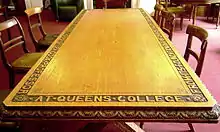
Preparatory School
| Name | Year |
|---|---|
| Reception | Reception |
| Form I | Year 1 |
| Form II | Year 2 |
| Form III | Year 3 |
| Form IV | Year 4 |
| Form V | Year 5 |
| Form VI | Year 6 |
College
| Year group | Queen's name | Section |
|---|---|---|
| Year 7 | Class 3 | The School |
| Year 8 | Class 2 | |
| Year 9 | Class 1 | |
| Year 10 | I Juniors | Junior College |
| Year 11 | II Juniors | |
| Year 12 | I Seniors | Senior College (Sixth Form) |
| Year 13 | II Seniors |
Ethos
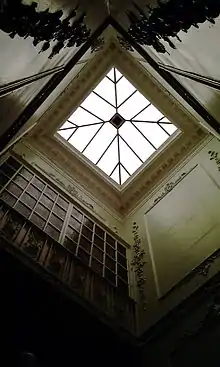
The teacher in every department, if he does his duty, will admonish his pupils that they are not to make fashion, or public opinion, their rule; that they are not to draw or play, or to study arithmetic, or language or literature or history, in order to shine or be admired; that if these are their ends, they will not be sincere in their work or do it well.[6] — F. D. Maurice
Religious affiliation
The College is Anglican in affiliation, stemming from its foundation under Christian Socialist F. D. Maurice. Half the principals since the College's inception have been vicars or canons of the Anglican Church. Today, the College is associated with the nearby All Souls Church, Langham Place, whose vicar is the school chaplain. Prayers are said daily in the hall (except on Thursday), and the year begins with the reading of a prayer written specially for the College by Maurice. Members of other faiths are welcomed and a weekly Jewish assembly takes place.
Calendar
Terms
The three terms are named: Michaelmas, Lent and Summer.
At the end of the Lent Term, Founder's Day is observed, when thanks is given for the founding of the College at All Souls Church, which is also the location of the carol service at the end of the Michaelmas Term.
Annual Gathering
The Summer Term closes with the Annual Gathering, when pupils continue the tradition, begun in 1854, of lining the school corridor dressed all in white, accompanied by the staff in academic dress. The 'Visitor', the Bishop of London, or his representative, is introduced by form tutors and the Principal to every student in the College from Class 1 upwards and selected representatives of Classes 2 and 3. The event is followed by the Principal's report to the governors, parents, staff and pupils on the academic year and an address from the Visitor.
Alumnae

Founded in 1891, the Old Queen's Society exists to connect former pupils with each other and the school. The first Honorary Secretary was Frideswide Kekewich and the first President, Ellen Howard.
Known as Old Queens,[7] alumnae have included many notable women over the school's history, including:
- Matilda Ellen Bishop (c.1858–60) first Principal of Royal Holloway College (1887–1897)
- Gertrude Bell (1884–86), archaeologist, cartologist, diplomat[8]
- Katherine Mansfield (1903–06), poet and author
- Rosalie Glynn Grylls, Lady Mander (1919–23, biographer, lecturer, Liberal politician, art collector, who wrote a history of the College
- Sofka Skipwith (Princess Sofka Dolgorouk), Russian émigré, Communist, political prisoner, recipient of British Hero of the Holocaust honour
- Anne Said (1925–30), artist
- Diana Barnato Walker (1928–34), author and aviator
- Mary Soames (1940), Chairman, Royal National Theatre Board and daughter of Winston Churchill
- Jacqueline du Pré, cellist (1959)
- Anna Wintour OBE (1960–3), editor-in-chief, Vogue magazine[9]
- Jane Asher, actress, entrepreneur, and philanthropist
- Hermione Lee (1963–65), biographer and Goldsmith Professor of English Literature, Oxford
- Harriet Cass, BBC announcer
- Daisy Goodwin (1972–77), BBC television producer
- Emma Freud (1973–80), broadcaster, member of the prominent Freud family
- Claudia Rosencrantz (1975–79), journalist, Controller of Entertainment, ITV, Commissioner of Who Wants to Be a Millionaire?, X Factor and I'm A Celebrity, Get Me Out of Here!, Director of Programming, Living TV, Director of Television, Virgin Media
- Susannah Constantine (1978), journalist, television presenter and fashion guru
- Asma al-Assad, First Lady of Syria
- Peaches Geldof, writer, presenter and model
- Amber Rudd (1979–81), MP
- Camilla Croudace, Lady Resident at Queen's College (1991-1906)
Heads of Queen's College
|
|
|
Members of staff
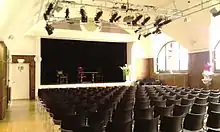
Former
- Terry Bagg, poet
- Dorothea Beale, suffragist and educational reformer[8]
- R. C. Trench[8]
- David Bedford, composer
- Louisa Bovell-Sturge, pioneering female doctor
- Isidore Brasseur, tutor to the Prince of Wales
- Émile Cammaerts, Belgian poet
- Richard Chenevix Trench, Dean of Westminster
- Henry Charles Innes Fripp, Professor of Art
- John Pyke Hullah, composer
- Janet Kay-Shuttleworth
- Elaine Kaye, author
- Charles Kingsley, author and social reformer
- David Laing, chaplain and secretary of the Governesses' Benevolent Institution
- Edward Collett May, music educator
- Fiona McIntosh, Olympian and former British number 1 fencer
- Tessa Millar, Olympic rower and coach
- Edward Plumptre, theologian[8]
- Anne Smith, world record holder for running the mile in 1967
- Henrietta Maria Stanley
- William Sterndale Bennett, composer, Principal of the Royal Academy of Music
- Ethel Truman, first woman to achieve a first in physics at London University
Secondary Sources
- Queen's College 1848–1948: Founded by Frederick Denison Maurice by Rosalie Glynn Grylls,[10] London: George Routledge & Sons, Ltd., 1948.
- A History of Queen's College, London 1848–1972 by Elaine Kaye,[11] London: Chatto and Windus, 1972.
- Queen's College: 150 Years and a New Century by Malcolm Billings, London: James & James, 2000.
External links
Footnotes and References
- Governance Archived 28 April 2012 at the Wayback Machine
- School History Archived 27 April 2012 at the Wayback Machine
- Billings, Malcolm (2000). Queen's College: 150 Years and a New Century. London: James & James. ISBN 0-907383-82-3.
- "Grove, Eleanor (1826–1905), educationist". Oxford Dictionary of National Biography. doi:10.1093/ref:odnb/48596. Retrieved 26 July 2020.
- "Morison, Rosa (1841–1912), educationist". Oxford Dictionary of National Biography. doi:10.1093/ref:odnb/48601. Retrieved 26 July 2020.
- Billings, Malcolm (2000). Queen's College: 150 Years and a New Century. London: James & James. pp. 39–40. ISBN 0-907383-82-3.
- "Queen's (London) | London – Inner (London postal codes) | Guide to Independent Schools". Schoolsguidebook.co.uk. Archived from the original on 10 September 2012. Retrieved 11 February 2011.
- "Croudace, Camilla Mary Julia (1844–1926), supporter of education for women | Oxford Dictionary of National Biography". www.oxforddnb.com. doi:10.1093/ref:odnb/52267. Retrieved 6 December 2019.
- Former pupils Archived 27 April 2012 at the Wayback Machine
- Old Queen, 1919–1923
- Former member of the staff and author of History of the King's Weigh House Church.